Öz
Uzmanlar kritik tıbbi analiz problemlerinde ilginç ve etkili yöntemleri başarıyla ortaya koydular. Bu alanlardan biri de sefalometrik analizdir. Sefalometrik analiz, insan kafatasının diş ve iskelet ilişkilerinin analizi sırasında hastanın kemik, diş ve yumuşak doku yapılarının yorumlanmasını kolaylaştırdığı için önemli rol oynar. Ortodonti ve ortopedi bölümlerinde ağız, kraniyofasiyal ve çene cerrahisi ve ortodontik tedaviler sırasında kullanılmaktadır. Sefalometrik yer işaretlerinin otomatik olarak konumlandırılması, olası insan hatalarını azaltır ve zamandan tasarruf sağlar. Sefalometrik yer işaretlerinin otomatik lokalizasyonunu gerçekleştirmek için U-Net modelinden esinlenerek bir derin öğrenme modeli önerilmiştir. Genellikle uzmanlar tarafından manuel olarak belirlenen 19 sefalometrik yer işareti bu model kullanılarak otomatik olarak elde edilir. Bu araştırma için IEEE 2015 Uluslararası Biyomedikal Görüntüleme Sempozyumu (ISBI 2015) kapsamında oluşturulan sefalometrik X-ray görüntü veri seti kullanılmış ve bu verisetine veri büyütme uygulanmıştır. 2 mm aralığında 74%, 2.5 mm aralığında 81.4%, 3 mm aralığında 86.3% ve 4 mm aralığında 92.2% Başarı Tespit Oranı (SDR) elde edildi.
Anahtar Kelimeler
Evrişimsel Sinir Ağları Sefalometrik Nokta Tespiti Tıbbi Görüntü Analizi Başarı Tespit Oranı
Kaynakça
- Qian, J., et al. CephaNet: An Improved Faster R-CNN for Cephalometric Landmark Detection. in 2019 IEEE 16th International Symposium on Biomedical Imaging (ISBI 2019). 2019. IEEE.
- Yue, W., et al., Automated 2-D cephalometric analysis on X-ray images by a model-based approach. IEEE transactions on biomedical engineering, 2006. 53(8): p. 1615-1623.
- Lindner, C. and T.F. Cootes. Fully automatic cephalometric evaluation using random forest regression-voting. in IEEE International Symposium on Biomedical Imaging. 2015. Citeseer.
- Ibragimov, B., et al. Computerized cephalometry by game theory with shape-and appearance-based landmark refinement. in Proceedings of International Symposium on Biomedical imaging (ISBI). 2015.
- Cardillo, J. and M.A. Sid-Ahmed, An image processing system for locating craniofacial landmarks. IEEE transactions on medical imaging, 1994. 13(2): p. 275-289.
- Lee, H., M. Park, and J. Kim. Cephalometric landmark detection in dental x-ray images using convolutional neural networks. in Medical Imaging 2017: Computer-Aided Diagnosis. 2017. International Society for Optics and Photonics.
- Lindner, C., et al., Fully automatic system for accurate localisation and analysis of cephalometric landmarks in lateral cephalograms. Scientific reports, 2016. 6: p. 33581.
- Jung, A.B., imgaug. Online; accessed 30-Oct-2018, 2018.
- Ronneberger, O., P. Fischer, and T. Brox. U-net: Convolutional networks for biomedical image segmentation. in International Conference on Medical image computing and computer-assisted intervention. 2015. Springer.
- Öztürk, Ş., and Özkaya, U. Skin lesion segmentation with improved convolutional neural network. Journal of digital imaging, 33(4), 958-970, 2020.
- Paszke, A., et al., Automatic differentiation in pytorch. 2017.
- Kingma, D.P. and J. Ba, Adam: A method for stochastic optimization. arXiv preprint arXiv:1412.6980, 2014.
- Wang, C.-W., et al., A benchmark for comparison of dental radiography analysis algorithms. Medical image analysis, 2016. 31: p. 63-76.
Öz
Experts have brought forward interesting and effective methods to address critical medical analysis problems. One of these fields of research is cephalometric analysis. During the analysis of tooth and the skeletal relationships of the human skull, cephalometric analysis plays an important role as it facilitates the interpretation of bone, tooth, and soft tissue structures of the patient. It is used during oral, craniofacial, and maxillofacial surgery and during treatments in orthodontic and orthopedic departments. The automatic localization of cephalometric landmarks reduces possible human errors and is time saving. To performed automatic localization of cephalometric landmarks, a deep learning model has been proposed inspired by the U-Net model. 19 cephalometric landmarks that are generally manually determined by experts are automatically obtained using this model. The cephalometric X-ray image dataset created under the context of IEEE 2015 International Symposium on Biomedical Imaging (ISBI 2015) is used and data augmentation is applied to it for this experiment. A Success Detection Rate SDR of 74% was achieved in the range of 2 mm, 81.4% in the range of 2.5mm, 86.3% in the range of 3mm, and 92.2% in the range of 4mm.
Anahtar Kelimeler
Convolutional Neural Networks Cephalometric Landmarks Detection Medical Image Analysis Success Detection Rate
Kaynakça
- Qian, J., et al. CephaNet: An Improved Faster R-CNN for Cephalometric Landmark Detection. in 2019 IEEE 16th International Symposium on Biomedical Imaging (ISBI 2019). 2019. IEEE.
- Yue, W., et al., Automated 2-D cephalometric analysis on X-ray images by a model-based approach. IEEE transactions on biomedical engineering, 2006. 53(8): p. 1615-1623.
- Lindner, C. and T.F. Cootes. Fully automatic cephalometric evaluation using random forest regression-voting. in IEEE International Symposium on Biomedical Imaging. 2015. Citeseer.
- Ibragimov, B., et al. Computerized cephalometry by game theory with shape-and appearance-based landmark refinement. in Proceedings of International Symposium on Biomedical imaging (ISBI). 2015.
- Cardillo, J. and M.A. Sid-Ahmed, An image processing system for locating craniofacial landmarks. IEEE transactions on medical imaging, 1994. 13(2): p. 275-289.
- Lee, H., M. Park, and J. Kim. Cephalometric landmark detection in dental x-ray images using convolutional neural networks. in Medical Imaging 2017: Computer-Aided Diagnosis. 2017. International Society for Optics and Photonics.
- Lindner, C., et al., Fully automatic system for accurate localisation and analysis of cephalometric landmarks in lateral cephalograms. Scientific reports, 2016. 6: p. 33581.
- Jung, A.B., imgaug. Online; accessed 30-Oct-2018, 2018.
- Ronneberger, O., P. Fischer, and T. Brox. U-net: Convolutional networks for biomedical image segmentation. in International Conference on Medical image computing and computer-assisted intervention. 2015. Springer.
- Öztürk, Ş., and Özkaya, U. Skin lesion segmentation with improved convolutional neural network. Journal of digital imaging, 33(4), 958-970, 2020.
- Paszke, A., et al., Automatic differentiation in pytorch. 2017.
- Kingma, D.P. and J. Ba, Adam: A method for stochastic optimization. arXiv preprint arXiv:1412.6980, 2014.
- Wang, C.-W., et al., A benchmark for comparison of dental radiography analysis algorithms. Medical image analysis, 2016. 31: p. 63-76.
Ayrıntılar
| Birincil Dil | İngilizce |
|---|---|
| Konular | Mühendislik |
| Bölüm | Makaleler |
| Yazarlar | |
| Yayımlanma Tarihi | 15 Aralık 2021 |
| Yayımlandığı Sayı | Yıl 2021 Sayı: 30 |


